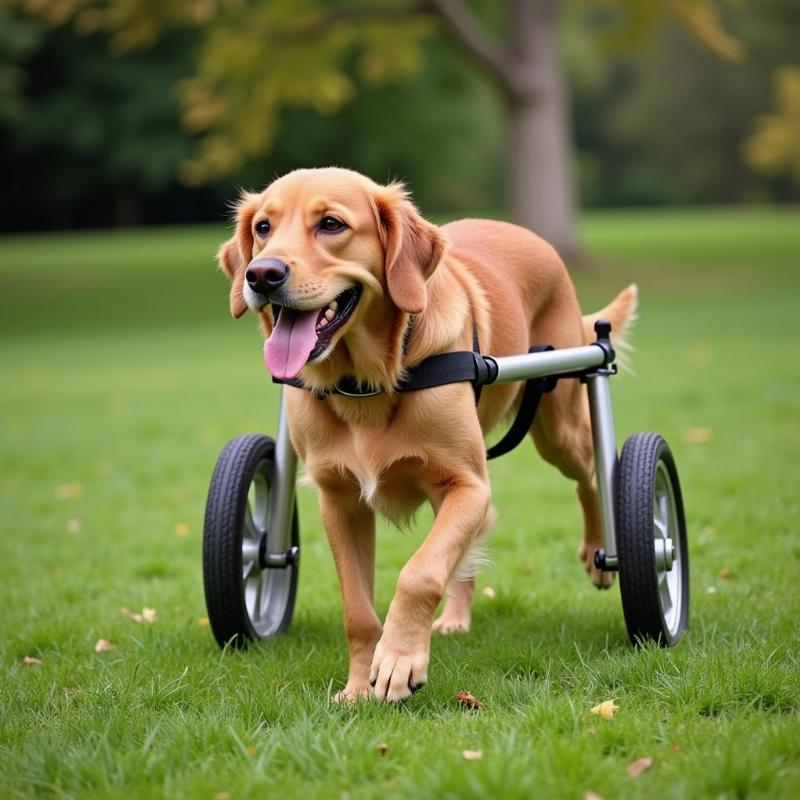Bad hips can significantly impact a dog’s mobility and quality of life. If your furry friend is struggling with hip dysplasia, arthritis, or other hip-related issues, wheels for dogs (also known as dog wheelchairs or carts) can offer a life-changing solution. They provide support, reduce pain, and allow your dog to continue enjoying walks, playtime, and their overall independence. This article will explore the benefits, types, and considerations when choosing wheels for dogs with bad hips, empowering you to make the best decision for your beloved companion.
Understanding the Need for Wheels for Dogs with Bad Hips
Hip problems in dogs can manifest in various ways, from limping and stiffness to difficulty climbing stairs or even standing. These issues can stem from genetic predispositions, age-related degeneration, or injuries. While medical treatments and therapies are essential, wheels can provide additional support and improve your dog’s overall well-being. They allow your dog to exercise without putting excessive strain on their hips, which is crucial for maintaining muscle mass and preventing further deterioration.
 Dog in a wheelchair enjoying the outdoors
Dog in a wheelchair enjoying the outdoors
Types of Wheels for Dogs
There are various types of wheels available, catering to different needs and sizes of dogs. The most common types include rear support wheelchairs, which are suitable for dogs with hind leg weakness, and quad wheelchairs, which provide support for all four legs. When choosing, consider your dog’s size, breed, and the specific hip condition. Adjustable carts are ideal as they can be customized as your dog’s needs change.
Choosing the Right Wheels for Your Dog
Selecting the appropriate wheels for your dog is crucial for their comfort and effectiveness. Consider factors like the frame material (lightweight aluminum is often preferred), adjustability, and the type of harness. Ensuring a proper fit is essential to prevent chafing and discomfort. Consulting with your veterinarian or a rehabilitation specialist can provide valuable guidance in choosing the right wheels for your dog’s specific needs.
Acclimating Your Dog to Wheels
Introducing your dog to wheels should be a gradual and positive process. Start by letting them sniff and explore the cart. Then, slowly introduce the harness and allow them to stand in the cart for short periods. Reward them with treats and praise to create a positive association. Gradually increase the time they spend in the cart, eventually progressing to short walks. Patience and positive reinforcement are key to a successful transition.
Benefits of Using Wheels for Dogs with Bad Hips
The benefits of using wheels extend beyond simply improving mobility. They can alleviate pain, improve muscle strength, and enhance your dog’s overall quality of life. By enabling them to continue participating in activities they enjoy, wheels can also have a positive impact on their mental well-being, reducing anxiety and depression often associated with mobility limitations.
Maintaining Your Dog’s Wheels
Proper maintenance is essential to ensure the longevity and effectiveness of your dog’s wheels. Regularly check for wear and tear, clean the wheels and frame, and lubricate moving parts as needed. Store the cart in a dry place to prevent rust and damage.
Conclusion: Giving Your Dog the Gift of Mobility
Wheels for dogs with bad hips can be a transformative tool, providing them with increased comfort, mobility, and overall well-being. By carefully considering the different types available and ensuring a proper fit, you can empower your furry friend to live a fuller, more active life, despite their hip condition. Remember, consulting with your veterinarian is crucial to ensure wheels are the right solution for your dog.
FAQ
- How do I know if my dog needs wheels? If your dog shows signs of hip pain, struggles with mobility, or has been diagnosed with a hip condition, consult your veterinarian. They can assess your dog’s needs and recommend appropriate solutions, including wheels.
- Are wheels suitable for all dogs with hip problems? While wheels can be beneficial for many dogs with hip issues, they may not be suitable for all cases. Your veterinarian can help determine if wheels are the right option for your dog’s specific condition.
- How long does it take for a dog to get used to wheels? The acclimation process varies depending on the dog’s temperament and the severity of their hip condition. Patience and positive reinforcement are crucial.
- Are wheels expensive? The cost of wheels varies depending on the type, size, and features. It’s best to research different options and compare prices.
- Can my dog still use the bathroom while using wheels? Most dog wheelchairs are designed to allow for normal bathroom functions.
- Where can I purchase wheels for my dog? Wheels for dogs can be purchased from pet supply stores, online retailers, and specialized mobility equipment providers.
- What should I look for when choosing wheels for my dog? Consider factors like your dog’s size, the severity of their hip condition, the adjustability of the cart, and the material of the frame.
Beautdogs.us: Your Trusted Source for Dog Care
Beautdogs.us is a leading online resource for comprehensive dog care information, breed-specific advice, and expert guidance on all aspects of dog ownership in the US. We cater to both new and experienced dog owners, offering valuable insights and resources. From breed information to product reviews, Beautdogs.us is your one-stop shop for ensuring your furry companion lives a happy, healthy, and fulfilling life. Contact us today for personalized support! Email: [email protected] Phone: +1 501-555-7529. Visit Beautdogs.us for all your dog-related needs!